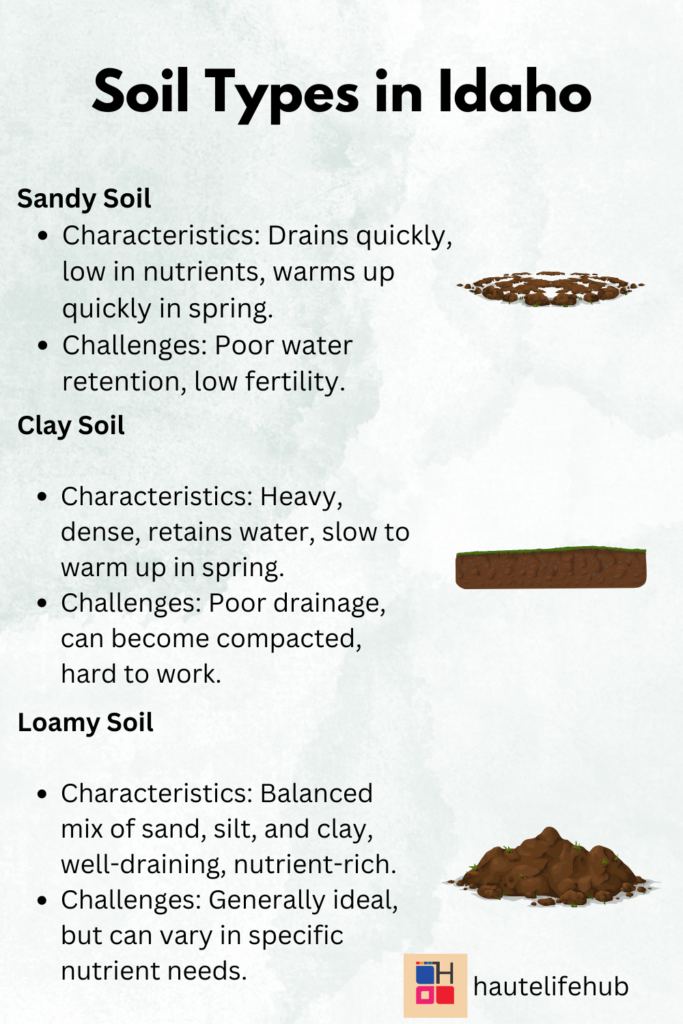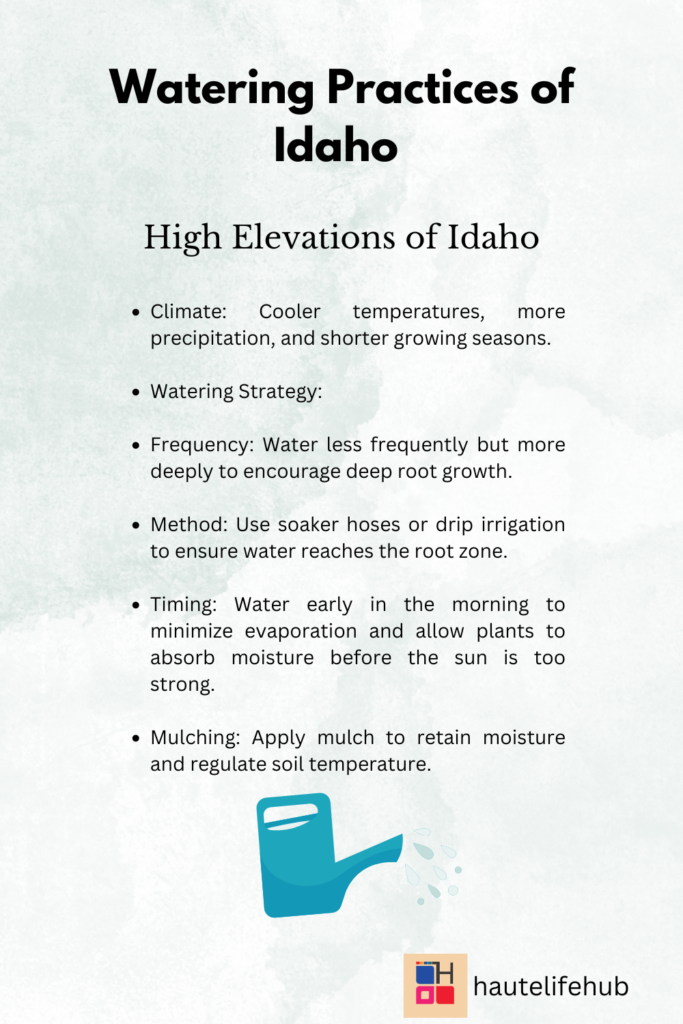Gardening in Idaho is a rewarding experience, offering diverse landscapes from lush valleys to rugged mountains. Whether you’re a novice or an experienced gardener, understanding Idaho’s unique gardening conditions can help you achieve a thriving garden.Gardening in Idaho is a journey that combines understanding the local climate, soil, and plant needs. By adapting your gardening practices to Idaho’s unique conditions, you can create a beautiful and productive garden.
1. Climate Zones of Idaho
Understanding Idaho’s climate zones is crucial for successful gardening. The USDA Hardiness Zones, ranging from 3 to 7, dictate which plants can thrive in different parts of the state. Here’s a breakdown:
(a)Zone 3-4
- Climate: Very cold winters with temperatures often dropping below -30°F.
- Suitable Plants: Cold-hardy perennials, shrubs, and trees.
- Examples: Spruce, pine, aspen, yarrow, and sedum.
(b)Zone 5-6
- Climate: Milder winters with temperatures ranging from -20°F to -10°F.
- Suitable Plants: A mix of perennials, annuals, and some fruit trees.
- Examples: Lilac, peony, daylily, apple trees, and cherry trees.
(c)Zone 7
- Climate: Warmer winters with temperatures ranging from 0°F to 10°F.
- Suitable Plants: A wider variety of vegetables, herbs, and flowers.
- Examples: Tomatoes, peppers, basil, lavender, roses, and many annual flowers.

2. Soil Types in Idaho
Idaho’s diverse soil types require different preparation techniques to create optimal growing conditions. Conducting a soil test is the first step to understanding your soil’s composition and pH level. Here’s how to manage different soil types:
Sandy Soil
- Characteristics: Drains quickly, low in nutrients, warms up quickly in spring.
- Challenges: Poor water retention, low fertility.
Clay Soil
- Characteristics: Heavy, dense, retains water, slow to warm up in spring.
- Challenges: Poor drainage, can become compacted, hard to work.
Loamy Soil
- Characteristics: Balanced mix of sand, silt, and clay, well-draining, nutrient-rich.
- Challenges: Generally ideal, but can vary in specific nutrient needs.

General Soil Preparation Steps in Idaho:
- Soil Test: Conduct a soil test to determine pH, nutrient levels, and soil type.
- Adjust pH: Amend soil to reach the desired pH for your plants (most garden plants prefer slightly acidic to neutral soil, pH 6.0-7.0).
- Amend Soil: Based on your soil test results, add necessary amendments to improve soil structure and fertility.
- Till and Mix: Till the soil to a depth of 8-12 inches, mixing in organic matter and amendments thoroughly.
- Mulch: Apply a layer of mulch to protect soil structure, conserve moisture, and suppress weeds.

3. Selecting the Right Plants in Idaho
Choosing plants that are well-suited to Idaho’s climate and soil conditions is essential for a successful garden. Native plants are particularly beneficial as they are adapted to the local environment, often requiring less maintenance and water. Here’s a guide to selecting the right plants for different categories:
Vegetables of Idaho
- Potatoes
- Why: Idaho’s well-draining soil and climate are ideal for potatoes.
- Varieties: Russet, Red, Yukon Gold.
- Carrots
- Why: Thrive in loose, well-drained soil.
- Varieties: Nantes, Danvers, Imperator.
- Beans
- Why: Adapt well to a range of soil types and climates.
- Varieties: Bush beans, pole beans.
- Tomatoes
- Why: Perform well in warmer zones and with adequate sunlight.
- Varieties: Roma, Beefsteak, Cherry.

Fruits of Idaho
- Apples
- Why: Suitable for Zones 5-7 with proper care.
- Varieties: Red Delicious, Golden Delicious, Gala.
- Cherries
- Why: Thrive in Zones 5-6 with cold winters.
- Varieties: Bing, Rainier, Montmorency.
- Berries
- Why: Adapt well to Idaho’s diverse soil types and climate.
- Varieties: Raspberries, blueberries, strawberries.

Flowers of Idaho
- Sunflowers
- Why: Hardy and thrive in well-draining soil with full sun.
- Varieties: Mammoth, Autumn Beauty, Teddy Bear.
- Lupines
- Why: Native to many parts of Idaho, attractive and hardy.
- Varieties: Russell hybrids, Wild lupine.
- Yarrow
- Why: Drought-tolerant, well-suited to Idaho’s climate.
- Varieties: Achillea millefolium, Red yarrow.

4. Watering Practices of Idaho
Watering is a crucial aspect of gardening, and understanding the specific needs of your region can make a significant difference in plant health and productivity. Here are some general guidelines and tips for watering in Idaho:
High Elevations of Idaho
- Climate: Cooler temperatures, more precipitation, and shorter growing seasons.
- Watering Strategy:
- Frequency: Water less frequently but more deeply to encourage deep root growth.
- Method: Use soaker hoses or drip irrigation to ensure water reaches the root zone.
- Timing: Water early in the morning to minimize evaporation and allow plants to absorb moisture before the sun is too strong.
- Mulching: Apply mulch to retain moisture and regulate soil temperature.

Lower Elevations of Idaho
- Climate: Warmer temperatures, less precipitation, and longer growing seasons.
- Frequency: Water more regularly, especially during hot, dry summer months.
- Method: Use drip irrigation systems to conserve water and deliver it directly to the roots.
- Timing: Water early in the morning or late in the evening to reduce evaporation.
- Mulching: Apply mulch to retain soil moisture and suppress weeds.

General Watering Tips in Idaho:
- Soil Moisture: Check soil moisture regularly to ensure plants are neither too dry nor too wet.
- Plant Needs: Different plants have varying water needs; group plants with similar requirements together.
- Avoid Overwatering: Too much water can lead to root rot and other issues; ensure proper drainage.
- Rainwater Harvesting: Collect rainwater to use for irrigation, reducing dependence on municipal water supplies.

5. Pests and Diseases in Idaho
Idaho gardeners may encounter a variety of pests and diseases that can affect plant health. Implementing Integrated Pest Management (IPM) strategies can help manage these issues effectively.
Common Pests in Idaho
1. Aphids
- Description: Small, soft-bodied insects that suck sap from plants, causing stunted growth and deformities.
- Control Methods:
- Natural Predators: Encourage beneficial insects like ladybugs and lacewings.
- Organic Pesticides: Use insecticidal soap or neem oil.
- Manual Removal: Spray aphids off plants with a strong jet of water.
2. Spider Mites
- Description: Tiny, spider-like pests that cause yellowing and stippling on leaves.
- Control Methods:
- Natural Predators: Introduce predatory mites.
- Organic Pesticides: Use insecticidal soap or horticultural oil.
- Environmental Control: Increase humidity around plants, as spider mites thrive in dry conditions.
3. Slugs
- Description: Soft-bodied mollusks that feed on leaves, leaving irregular holes.
- Control Methods:
- Natural Predators: Encourage birds, frogs, and ground beetles.
- Organic Barriers: Use diatomaceous earth or crushed eggshells around plants.
- Manual Removal: Handpick slugs during the evening or early morning.

Common Plant Diseases in Idaho:
1. Powdery Mildew
- Description: White, powdery growth on leaves and stems.
- Control Methods:
- Cultural Controls: Improve air circulation by proper spacing and pruning.
- Organic Fungicides: Apply sulfur or neem oil.
- Water Management: Avoid overhead watering to reduce humidity around plants.
2. Blight (Tomatoes and Potatoes)
- Description: Dark spots on leaves and stems, leading to wilting and plant death.
- Control Methods:
- Cultural Controls: Rotate crops and avoid planting tomatoes and potatoes in the same location each year.
- Organic Fungicides: Use copper-based fungicides.
- Sanitation: Remove and destroy infected plant material.
3. Downy Mildew
- Description: Yellow patches on leaves with a downy growth on the underside.
- Control Methods:
- Cultural Controls: Improve air circulation and reduce leaf wetness.
- Organic Fungicides: Apply copper or biological fungicides.
- Water Management: Water plants at the base to keep foliage dry.
Integrated Pest Management (IPM) Strategies:
By incorporating these IPM strategies, Idaho gardeners can effectively manage pests and diseases, ensuring a healthy and productive garden.
1. Prevention:
- Garden Cleanliness: Remove dead plant material and debris to reduce pest habitats.
- Crop Rotation: Rotate crops annually to break pest and disease cycles.
- Resistant Varieties: Choose disease-resistant plant varieties.
2. Monitoring:
- Regular Inspections: Check plants frequently for signs of pests or diseases.
- Early Detection: Identify problems early to take swift action.
3. Control:
- Natural Predators: Introduce and support beneficial insects and animals that prey on pests.
- Organic Pesticides: Use environmentally friendly pesticides as needed.
- Manual Removal: Handpick pests or use barriers and traps.

6. Community Resources for Idaho Gardeners
Accessing local resources can significantly enhance your gardening experience in Idaho. Here are some valuable community resources for gardeners in the state:
University of Idaho Extension
- Services: Provides research-based information and educational programs on gardening, agriculture, and pest management.
- Resources: Workshops, publications, soil testing, and Master Gardener Program.
- Website: University of Idaho Extension
Idaho Master Gardener Program
- Services: Trains volunteers to provide gardening advice and education to the community.
- Resources: Classes, volunteer opportunities, and gardening hotlines.
- Website: Idaho Master Gardener Program
Local Gardening Clubs and Societies
- Examples:
- Idaho Native Plant Society: Focuses on the conservation and appreciation of Idaho’s native plants.
- Boise Community Garden: Provides space and support for community gardening efforts.
- Resources: Meetings, plant sales, garden tours, and educational events.
Nurseries and Garden Centers
- Services: Offer a wide selection of plants, gardening supplies, and expert advice.
- Examples:
- FarWest Garden Center (Boise): Provides a variety of plants suited for Idaho’s climate.
- North End Organic Nursery (Boise): Specializes in organic and heirloom plants.
- Madeline George Garden Design Nursery (Boise): Offers garden design services and a range of plants.
Community Gardens
- Benefits: Provide space for those without their own gardening area, promote community engagement, and offer fresh produce.
- Examples:
- Boise Urban Garden School (BUGS): Offers educational programs and community garden plots.
- Pocatello Community Garden: Provides garden plots for local residents.


